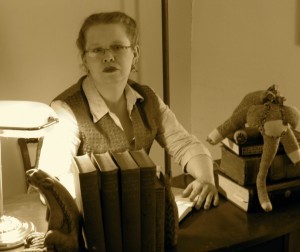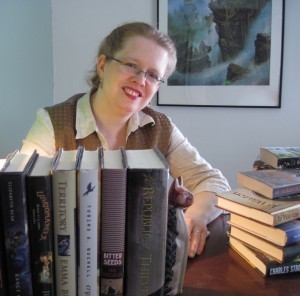Katherine Addison's Blog, page 53
March 6, 2014
UBC: Stout
Stout, David. The Boy in the Box: The Unsolved Case of America's Unknown Child. Guilford, CT: The Lyons Press-The Globe Pequot Press, 2008.
The Boy in the Box (later pretentiously renamed America's Unknown Child) was a child, somewhere between four and six years old, found in a cardboard box in Philadelphia in February 1957. He had been beaten to death. Despite what seemed like any number of promising clues, including surgical scars, he has, to this day, not been positively identified, and at this point, every passing day makes it more likely that the person or persons who could have identified him are dead themselves.
(I have had this sentence running through my head for a couple days now: If the living don't remember the dead, who will? It seems to be some sort of morbid koan, since it is the most utterly rhetorical of rhetorical questions and yet won't leave me alone.)
This is the book Somebody's Daughter wanted to be. Stout is telling the story of the Boy in the Box and of the investigators who kept searching for answers for fifty years, and he's also telling the story of how, over those same fifty years, cases like Bobby Greenlease, Steven Damman, Adam Walsh, Mary Beth Tinning, Stephen Van Der Sluys, Waneta Hoyt, Marie Noe, Little Miss 1565, Jerell Willis (the Boy in the Bag), Angelica Evergreen, and Riley Ann Sawyers (Baby Grace), were changing societal awareness of the vulnerability of small children--particularly their vulnerability at the hands of their caregivers. And, of course, the terrible threnody of the children who are lost and never found, like Steven Damman, and the children who are found and never identified, like the Boy in the Box.
There is a vein of sentimentality in Stout, toward both the Boy in the Box and toward the investigators, and while it's understandable, I find it cloying and distracting. But, obviously, this is a fast and gripping read (I started it over dinner last night and finished it before I went to bed), and Stout does an excellent job of telling the story of an unsuccessful investigation and all the competing narratives it spawns.
This is a sad book in many ways--none of these children can be saved, and the investigators' persistence (and sometimes obsession) is not rewarded. But it is also a hopeful book, because for every Mary Beth Tinning and Stephen Van Der Sluys, there is someone who is trying to make things better, to find answers, to bring Waneta Hoyt and Marie Noe to justice. And ultimately, this is the story of people (including Stout himself) who are insisting on REMEMBERING the Boy in the Box, who care even though they have no reason to. It's this quixotic streak that balances the terrible savagery in human nature, and Stout does a remarkably good job of encompassing both.
The Boy in the Box (later pretentiously renamed America's Unknown Child) was a child, somewhere between four and six years old, found in a cardboard box in Philadelphia in February 1957. He had been beaten to death. Despite what seemed like any number of promising clues, including surgical scars, he has, to this day, not been positively identified, and at this point, every passing day makes it more likely that the person or persons who could have identified him are dead themselves.
(I have had this sentence running through my head for a couple days now: If the living don't remember the dead, who will? It seems to be some sort of morbid koan, since it is the most utterly rhetorical of rhetorical questions and yet won't leave me alone.)
This is the book Somebody's Daughter wanted to be. Stout is telling the story of the Boy in the Box and of the investigators who kept searching for answers for fifty years, and he's also telling the story of how, over those same fifty years, cases like Bobby Greenlease, Steven Damman, Adam Walsh, Mary Beth Tinning, Stephen Van Der Sluys, Waneta Hoyt, Marie Noe, Little Miss 1565, Jerell Willis (the Boy in the Bag), Angelica Evergreen, and Riley Ann Sawyers (Baby Grace), were changing societal awareness of the vulnerability of small children--particularly their vulnerability at the hands of their caregivers. And, of course, the terrible threnody of the children who are lost and never found, like Steven Damman, and the children who are found and never identified, like the Boy in the Box.
There is a vein of sentimentality in Stout, toward both the Boy in the Box and toward the investigators, and while it's understandable, I find it cloying and distracting. But, obviously, this is a fast and gripping read (I started it over dinner last night and finished it before I went to bed), and Stout does an excellent job of telling the story of an unsuccessful investigation and all the competing narratives it spawns.
This is a sad book in many ways--none of these children can be saved, and the investigators' persistence (and sometimes obsession) is not rewarded. But it is also a hopeful book, because for every Mary Beth Tinning and Stephen Van Der Sluys, there is someone who is trying to make things better, to find answers, to bring Waneta Hoyt and Marie Noe to justice. And ultimately, this is the story of people (including Stout himself) who are insisting on REMEMBERING the Boy in the Box, who care even though they have no reason to. It's this quixotic streak that balances the terrible savagery in human nature, and Stout does a remarkably good job of encompassing both.
Published on March 06, 2014 11:33
March 5, 2014
UBC: Cowan & Kuenster
Cowan, David, and John Kuenster. To Sleep with the Angels: The Story of a Fire. Chicago: Elephant Paperbacks-Ivan R. Dee, 1996.
The fire at Our Lady of Angels School on December 1, 1958, killed 92 children and 3 nuns, caused radical changes in the fire codes for schools, and remains unsolved. Cowan & Kuenster describe the course of the disaster, the horrible aftermath, and the efforts of the investigators (sometimes against pushback from the Catholic Church) to find the person responsible. There have been two confessions, both later recanted, and no way now, in all likelihood, that the mystery will ever be definitively solved.
There are any number of horrible things about this fire, beyond the fact that it happened at all: the fact that many of the victims probably died because, even though they were aware the school was on fire, school policy was that they could not leave their classrooms unless the fire alarm rang and the fire alarm (which had to be manually triggered) failed to ring until it was too late; the fact that the only fire escape was LOCKED (and even when it was unlocked, it was in the back of the smallest of the classrooms and thus in practice only available to the children in that room); the fact that after the fire, the surviving children were told that the ones who died were the good ones, and that's why God took them; the inevitable way in which the legacy of stricter, safer fire codes was undercut and subverted by human greed and laziness. But the thing that terrified me the most was how fast it happened. (Not that this is surprising--it's no secret that fire moves fast--but this book, like Young Men and Fire, lays out that speed so that you can look at it and understand what it means.) It's not entirely clear when the fire started, or when it was first noticed, but the first call to the Fire Department was received at 2:42, the first fire trucks arrived at 2:44, and although Cowan and Kuenster's timeline is not precise, my guess is that by 2:50, seven minutes before it was declared a five-alarm fire, it was already too late. Everyone who was going to make it out of the school already had, and everyone who hadn't was already dead (and some of those who made it out were dying--the last death from the fire was in August 1959).
This is, in fact, a very good book. Cowan & Kuenster tell the story clearly and with sympathy for both victims and survivors. They fall back on clichés occasionally, but their subject is one that pushes constantly toward the boundaries of the literally undescribable, and I commend them for writing about it as well as they do.
There is a website devoted to the fire, if you're looking for more information.
The fire at Our Lady of Angels School on December 1, 1958, killed 92 children and 3 nuns, caused radical changes in the fire codes for schools, and remains unsolved. Cowan & Kuenster describe the course of the disaster, the horrible aftermath, and the efforts of the investigators (sometimes against pushback from the Catholic Church) to find the person responsible. There have been two confessions, both later recanted, and no way now, in all likelihood, that the mystery will ever be definitively solved.
There are any number of horrible things about this fire, beyond the fact that it happened at all: the fact that many of the victims probably died because, even though they were aware the school was on fire, school policy was that they could not leave their classrooms unless the fire alarm rang and the fire alarm (which had to be manually triggered) failed to ring until it was too late; the fact that the only fire escape was LOCKED (and even when it was unlocked, it was in the back of the smallest of the classrooms and thus in practice only available to the children in that room); the fact that after the fire, the surviving children were told that the ones who died were the good ones, and that's why God took them; the inevitable way in which the legacy of stricter, safer fire codes was undercut and subverted by human greed and laziness. But the thing that terrified me the most was how fast it happened. (Not that this is surprising--it's no secret that fire moves fast--but this book, like Young Men and Fire, lays out that speed so that you can look at it and understand what it means.) It's not entirely clear when the fire started, or when it was first noticed, but the first call to the Fire Department was received at 2:42, the first fire trucks arrived at 2:44, and although Cowan and Kuenster's timeline is not precise, my guess is that by 2:50, seven minutes before it was declared a five-alarm fire, it was already too late. Everyone who was going to make it out of the school already had, and everyone who hadn't was already dead (and some of those who made it out were dying--the last death from the fire was in August 1959).
This is, in fact, a very good book. Cowan & Kuenster tell the story clearly and with sympathy for both victims and survivors. They fall back on clichés occasionally, but their subject is one that pushes constantly toward the boundaries of the literally undescribable, and I commend them for writing about it as well as they do.
There is a website devoted to the fire, if you're looking for more information.
Published on March 05, 2014 13:50
March 4, 2014
THE GOBLIN EMPEROR: Chapter 4
Published on March 04, 2014 12:25
March 3, 2014
THE GOBLIN EMPEROR: Chapter 3
Tor.com has posted Chapter 3 of The Goblin Emperor. (Chapters 1 & 2 are still available for download here.)
So for those of you who wanted just a little bit more . . .
So for those of you who wanted just a little bit more . . .
Published on March 03, 2014 10:20
March 2, 2014
Katherine Addison
So my publicist at Tor asked if she could get a headshot of Katherine Addison for dissemination to Tor.com and C2E2 and the like, and I thought, What the hell. If I'm going to do it, I might as well go all out.
So this is baseline me, as you should imagine me behind pretty much anything I post:

And this is Katherine Addison, who turns out to be a steampunk kind of lady:

She takes good headshots, too:



So this is baseline me, as you should imagine me behind pretty much anything I post:

And this is Katherine Addison, who turns out to be a steampunk kind of lady:

She takes good headshots, too:



Published on March 02, 2014 12:49
February 27, 2014
UBC: Collins, Merritt, O'Brien
Collins, Paul. The Murder of the Century: The Gilded Age Crime That Scandalized a City & Sparked The Tabloid Wars. New York: Crown Publishers, 2011.
Merritt, Greg. Room 1219: The Life of Fatty Arbuckle, the Mysterious Death of Virginia Rappe, and the Scandal that Changed Hollywood. Chicago: A Cappella-Chicago Review Press, 2013.
O'Brien, Geoffrey. The Fall of the House of Walworth: A Tale of Madness and Murder in Gilded Age America. New York: St. Martin's Griffin, 2010.
These three books are about cause célèbre murders, each about twenty years apart: 1873, 1897, 1921. And one of the interesting things about them is that, of the three, the only one anyone now has even heard of is the one that wasn't a murder at all: the death of Virginia Rappe--and most of what we vaguely "know" about her death is wrong. About the other two, the murder of Mansfield Tracy Walworth by his son Frank and the murder of William Guldensuppe by Augusta Nack and Martin Thorn, I feel fairly safe in saying that, unless you've read O'Brien or Collins, you've never heard a thing. And yet these were HOWLED about by the newspapers in 1873 and 1897 and both have a certain amount of historical importance, the Walworth murder for being the first second-degree murder trial in New York, the Guldensuppe murder for the comet-like rise of the repellent William Randolph Hearst and his Journal. So one of the things I learned from all three books is how quickly a cause célèbre evaporates from human memory.
All three of these books are excellent, although each is very different from the other two. The O'Brien is intensely Gothic Victorian, as are the lives of its subjects. (I was half persuaded, all the way through, that I was being gaslighted and The Fall of the House of Walworth was actually a novel. But the central person of the book, Ellen Hardin Walworth, was one of the founders of the DAR, so if it's a scam, the Daughters of the American Revolution are in on it.) It is in some ways the most frustrating of the three, not because of anything O'Brien is doing wrong, but because, first of all, the people are frustrating for their failures and their blindnesses (as real people are wont to be), especially Ellen Hardin Walworth herself, who, for all the time she spent in introspection, never seems to have seen herself clearly at all. (Mansfield is not frustrating. Mansfield is HORRIFYING, and I admit I ended up reading those parts of the book in breathless curiosity about what awful thing Mansfield would do next.)
The other reason for frustration is that the central ACT of the book, the murder of Mansfield Walworth, remains inaccessible. It is not a mystery--there was never any doubt, first to last, that Frank Walworth murdered his father--but it simply cannot be seen. One of the other things these three books have shown me with bitter clarity is that murder trials are not about finding the truth. They are about the competition of narratives, and both prosecution and defense will shape their narrative to defeat the competition, not to try to reveal the truth about anything. And all we know about the murder of Mansfield Walworth comes from Frank's trial. Was it premeditated, as the prosecution argued? Was Frank epileptic, as the defense argued, and ought he to be found therefore not guilty by reason of insanity? (Victorian doctors considered epilepsy a form of insanity.) The evidence is both scant and contradictory, and we are left simply not knowing. O'Brien is far more a biographer than a criminologist; he doesn't assess the evidence for or against, makes no effort at a meta-narrative. I find that frustrating, but I also recognize that that's because I come to these things as a mystery reader first and a historian (insofar as I can make any claim to that title) second. His failure to do what I want is not a flaw. And what he is doing, he does brilliantly.
Collins, on the other hand, is writing for mystery readers as well as for historians, and his book does explicitly what I often wish true crime books would do. He follows the course of the discovery of Guldensuppe's dismembered body, the course of the investigation, the trial, the execution of Martin Thorn and what can be determined about the later life of Augusta Nack, and then he steps back and points out that the evidence tells a story that never came out in the trial, because, after Nack turned state's evidence, she and Thorn were both committed to insisting on the complete innocence of themselves and the complete guilt of the other party. Nack's narrative won, and the truth--that the wounds on Guldensuppe's body indicate that Nack and Thorn must have been working together--was at that point simply not important enough to anyone to be bothered with.
(Apparently, I am an idealist. It offends me that there is no space in our legal system for anyone to say, "Both prosecution and defense are bypassing the truth.")
Collins' book is the most straightforward of the three, the most clearly a "true crime" book. He tells a complicated story consisely and elegantly and has done all kinds of research. But the book does not have either the baroque form-mirroring-content style of O'Brien's or the argumentative thesis of Merritt's.
Merritt's book is a biography of Roscoe Arbuckle (he put up with the nickname "Fatty" for his career, but no one who knew him called him that), and of Virginia Rappe (pronounced "rappay"), insofar as Merritt was able to unearth information about her; it is also, therefore, an excellent book about silent movies and the beginnings of Hollywood. But mostly it is the terrible story of the point where Arbuckle and Rappe's lives intersected and the consequences thereof. Merritt is passionately interested in finding the truth, about Rappe as much about Arbuckle, and dispelling the myths: he raped her with a bottle; she "had it coming" because she was a slut. I don't entirely know if I agree with his conclusions, but I appreciate the care with which he lays out the shreds and shards of evidence we have around the missing central act of what happened in Room 1219.
The terrible thing about Roscoe Arbuckle is that he is a sort of Schrodinger's cat of justice. If he did attempt to rape Virginia Rappe and thus caused her death, he got away with it. Tried three times and acquitted of manslaughter. But if he didn't attempt to rape her, if her death was truly the ghastly accident Merritt thinks it was, then his fate, the destruction of his career, was unjustifiably cruel. In neither case can one feel that justice was served.
Merritt, Greg. Room 1219: The Life of Fatty Arbuckle, the Mysterious Death of Virginia Rappe, and the Scandal that Changed Hollywood. Chicago: A Cappella-Chicago Review Press, 2013.
O'Brien, Geoffrey. The Fall of the House of Walworth: A Tale of Madness and Murder in Gilded Age America. New York: St. Martin's Griffin, 2010.
These three books are about cause célèbre murders, each about twenty years apart: 1873, 1897, 1921. And one of the interesting things about them is that, of the three, the only one anyone now has even heard of is the one that wasn't a murder at all: the death of Virginia Rappe--and most of what we vaguely "know" about her death is wrong. About the other two, the murder of Mansfield Tracy Walworth by his son Frank and the murder of William Guldensuppe by Augusta Nack and Martin Thorn, I feel fairly safe in saying that, unless you've read O'Brien or Collins, you've never heard a thing. And yet these were HOWLED about by the newspapers in 1873 and 1897 and both have a certain amount of historical importance, the Walworth murder for being the first second-degree murder trial in New York, the Guldensuppe murder for the comet-like rise of the repellent William Randolph Hearst and his Journal. So one of the things I learned from all three books is how quickly a cause célèbre evaporates from human memory.
All three of these books are excellent, although each is very different from the other two. The O'Brien is intensely Gothic Victorian, as are the lives of its subjects. (I was half persuaded, all the way through, that I was being gaslighted and The Fall of the House of Walworth was actually a novel. But the central person of the book, Ellen Hardin Walworth, was one of the founders of the DAR, so if it's a scam, the Daughters of the American Revolution are in on it.) It is in some ways the most frustrating of the three, not because of anything O'Brien is doing wrong, but because, first of all, the people are frustrating for their failures and their blindnesses (as real people are wont to be), especially Ellen Hardin Walworth herself, who, for all the time she spent in introspection, never seems to have seen herself clearly at all. (Mansfield is not frustrating. Mansfield is HORRIFYING, and I admit I ended up reading those parts of the book in breathless curiosity about what awful thing Mansfield would do next.)
The other reason for frustration is that the central ACT of the book, the murder of Mansfield Walworth, remains inaccessible. It is not a mystery--there was never any doubt, first to last, that Frank Walworth murdered his father--but it simply cannot be seen. One of the other things these three books have shown me with bitter clarity is that murder trials are not about finding the truth. They are about the competition of narratives, and both prosecution and defense will shape their narrative to defeat the competition, not to try to reveal the truth about anything. And all we know about the murder of Mansfield Walworth comes from Frank's trial. Was it premeditated, as the prosecution argued? Was Frank epileptic, as the defense argued, and ought he to be found therefore not guilty by reason of insanity? (Victorian doctors considered epilepsy a form of insanity.) The evidence is both scant and contradictory, and we are left simply not knowing. O'Brien is far more a biographer than a criminologist; he doesn't assess the evidence for or against, makes no effort at a meta-narrative. I find that frustrating, but I also recognize that that's because I come to these things as a mystery reader first and a historian (insofar as I can make any claim to that title) second. His failure to do what I want is not a flaw. And what he is doing, he does brilliantly.
Collins, on the other hand, is writing for mystery readers as well as for historians, and his book does explicitly what I often wish true crime books would do. He follows the course of the discovery of Guldensuppe's dismembered body, the course of the investigation, the trial, the execution of Martin Thorn and what can be determined about the later life of Augusta Nack, and then he steps back and points out that the evidence tells a story that never came out in the trial, because, after Nack turned state's evidence, she and Thorn were both committed to insisting on the complete innocence of themselves and the complete guilt of the other party. Nack's narrative won, and the truth--that the wounds on Guldensuppe's body indicate that Nack and Thorn must have been working together--was at that point simply not important enough to anyone to be bothered with.
(Apparently, I am an idealist. It offends me that there is no space in our legal system for anyone to say, "Both prosecution and defense are bypassing the truth.")
Collins' book is the most straightforward of the three, the most clearly a "true crime" book. He tells a complicated story consisely and elegantly and has done all kinds of research. But the book does not have either the baroque form-mirroring-content style of O'Brien's or the argumentative thesis of Merritt's.
Merritt's book is a biography of Roscoe Arbuckle (he put up with the nickname "Fatty" for his career, but no one who knew him called him that), and of Virginia Rappe (pronounced "rappay"), insofar as Merritt was able to unearth information about her; it is also, therefore, an excellent book about silent movies and the beginnings of Hollywood. But mostly it is the terrible story of the point where Arbuckle and Rappe's lives intersected and the consequences thereof. Merritt is passionately interested in finding the truth, about Rappe as much about Arbuckle, and dispelling the myths: he raped her with a bottle; she "had it coming" because she was a slut. I don't entirely know if I agree with his conclusions, but I appreciate the care with which he lays out the shreds and shards of evidence we have around the missing central act of what happened in Room 1219.
The terrible thing about Roscoe Arbuckle is that he is a sort of Schrodinger's cat of justice. If he did attempt to rape Virginia Rappe and thus caused her death, he got away with it. Tried three times and acquitted of manslaughter. But if he didn't attempt to rape her, if her death was truly the ghastly accident Merritt thinks it was, then his fate, the destruction of his career, was unjustifiably cruel. In neither case can one feel that justice was served.
Published on February 27, 2014 13:07
February 26, 2014
The Hounds of Winter
More Mirkwood by Tiffany this morning, a little more traditional but still eerily lovely:


And this is the fang a Hound of Winter left in the apple tree whilst prowling around our house:



And this is the fang a Hound of Winter left in the apple tree whilst prowling around our house:

Published on February 26, 2014 11:01
February 25, 2014
In memoriam: Harold Ramis
Harold Ramis died yesterday.
Egon Spengler lives on, because cinematographic technology preserves him forever (or at least for a good while longer), and thank goodness for that.
But I am still just . . . I am a little bit heartbroken.
Egon Spengler lives on, because cinematographic technology preserves him forever (or at least for a good while longer), and thank goodness for that.
But I am still just . . . I am a little bit heartbroken.
Published on February 25, 2014 12:01
February 23, 2014
Translation asymmetry and a way to fight it
Ben Rosenbaum has a great idea about redressing the imbalance between the translation of Anglophone authors into other languages and the tranlsation of non-Anglophone authors into English. (Hint: the imbalance is enormous.) Aliette de Bodard and Alex Shvartsman are on board. Which puts the languages available at: German, Spanish, French, Russian, Hebrew, and Vietnamese (with varying degrees of fluency on the part of the volunteer translators).
I would love to be able to add my name to the list, but the languages I am best at are dead. (Also, even if anyone wanted to trust my very rusty French, I honestly don't have the time/energy to commit to it. I was a Classics major in college; I know just how demanding a job translation is, and I know I can't do it right now.) But I want to do what I can, which is to boost the signal and encourage other authors to join in.
Seriously. This is a GREAT idea.
I would love to be able to add my name to the list, but the languages I am best at are dead. (Also, even if anyone wanted to trust my very rusty French, I honestly don't have the time/energy to commit to it. I was a Classics major in college; I know just how demanding a job translation is, and I know I can't do it right now.) But I want to do what I can, which is to boost the signal and encourage other authors to join in.
Seriously. This is a GREAT idea.
Published on February 23, 2014 08:41
REMINDER: Con or Bust
The Con or Bust auction ends at 5 p.m. Eastern Standard Time today.
This is me encouraging you, if you were thinking about bidding on something, to do so!
(Please forgive any infelicities. I have a migraine.)
This is me encouraging you, if you were thinking about bidding on something, to do so!
(Please forgive any infelicities. I have a migraine.)
Published on February 23, 2014 07:37



